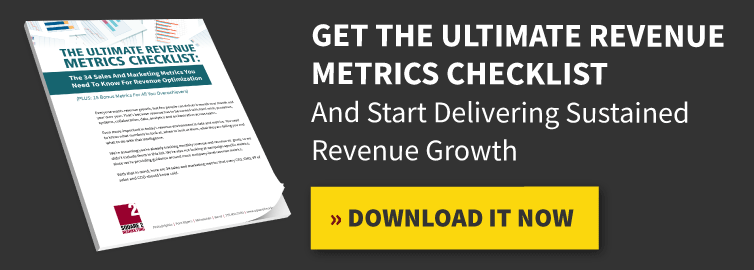
Is It Time To Retire MQLs As The Measure Of Successful Marketing?
If So, What Are The Right Metrics For Measuring Marketing In 2020?
 I don’t write this article casually. The idea of retiring the key indicator of success for my entire profession, my 17-year-old agency and perhaps what has become part of my DNA isn’t easy.
I don’t write this article casually. The idea of retiring the key indicator of success for my entire profession, my 17-year-old agency and perhaps what has become part of my DNA isn’t easy.
But change isn’t easy, and for 17 years I’ve been advising business leaders to make hard changes based on data.
Here we are, talking about how marketing-qualified leads (MQLs) might not be the right measure of success when it comes to the effectiveness and efficiency of your marketing programs.
Of course, a lot of thinking, research and experiments have gone into this consideration. I should also be transparent that many more experiments are underway to continue to inform this decision.
We have always viewed Square 2 as a lab where we test theories, tactics and methodologies before they get deployed to clients. Experimenting on clients has never been OK with us.But it does look like it’s time to reset expectations around how you measure the performance of your marketing.
The Back Story
I think it’s worth reflecting on where we’ve been and why now is the right time to consider making a change like this one.
We’ve worked with small and medium-sized businesses (and a handful of big businesses) for almost 20 years. The CEOs and business leaders who we’ve worked with have always been laser-focused on sales and new customer acquisition as the key metric.
This despite the fact that they have long sales cycles (some more than a year), their sales processes and sales teams are horrible, and they didn’t hire us to help them with sales improvements.
This made marketing-qualified leads the key metric we had an ability to impact and improve dramatically. And we did it well.
Clients saw, in some cases, a 10x improvement in leads generated. In many cases, client had zero leads from marketing programs when we arrived. Going from zero to 20 or 30 leads in a month is common.
But even with those companies, we still had to remind their leaders that sales is a lagging indicator, and we haven’t been asked to help them close new business.
To some extent, we are in a better position to use the metrics that our clients have always wanted to use.
What Changed?
 Yes, this is the right question. Why now is it OK to consider other metrics to define success? Why is it finally OK to do what clients have been asking about for years?
Yes, this is the right question. Why now is it OK to consider other metrics to define success? Why is it finally OK to do what clients have been asking about for years?
There are a couple of factors worth looking at.
First, technology has made it much easier to connect revenue with marketing that influenced purchase behavior. This is called revenue attribution, and it has become much easier in the technology tools to attribute revenue to marketing campaigns.
Next, because of buyer behavior, the line between marketing and sales is getting very blurry. We wrote a book eight years ago called “Fire Your Sales Team Today” that encouraged companies to blow up sales and marketing, and rebuild it as a single revenue team with a chief revenue officer. This model is much more common today.
Finally, because of how people buy, the technology and the changes in the ways companies are now looking at revenue generation, more companies are letting us help out in sales. Interestingly, it doesn’t feel like a conscious decision; it feels like a more natural extension of our work is now pulling us into the sales process, sales technology, sales tools and how sales interacts with prospects.
What we called the Guided Sales Process (from our book, “Fire Your Sales Team Today”) is becoming what companies want for their sales process, primarily because that’s how prospects want to be working with salespeople in today’s world. They want to be guided, advised and educated, not sold to.
If these changes are now getting traction, then how should you measure the success of your marketing programs? Here are the options we’re experimenting with today.
Sales-Qualified Leads
This metric offers the most natural option. Instead of people who simply download content or express some early buyer journey interest in your content, by using sales-qualified leads (SQLs) as the measure, you’re looking at people who have a later-stage buyer journey interest in talking to your sales team.
Remember, SQLs are people who are active in their buyer journey and want to talk to a salesperson.
If you still believe, as I do, that marketing-qualified leads are important and by extension nurturing those MQLs is critical, then if you do a good job of generating MQLs and nurturing those MQLs, you will generate more SQLs.
By extension, tracking and measuring SQLs would capture your effectiveness at generating and nurturing early buyer journey leads.
There is a constant conversation about the quality of MQLs. I wrote an article recently that talks about the common practice to discredit the quality of MQLs simply because they are not ready to buy. This removes that conversation entirely.
If the quality of SQLs is poor, sales will identify that quickly. Plus, with technology, SQLs can be pre-qualified a number of ways before reps even touch them for the first time. And by applying solid buyer journey mapping and late-stage buyer journey offer development, marketers can create a solid flow of high-quality sales-qualified leads for sales.
Sales Opportunities
Another option is sales opportunities. For definition purposes, sales opportunities are people who meet your qualification criteria. Sales-qualified leads are people who want to talk to you, and sales opportunities are people who you want to talk to because they are power, they’re a good fit and they have acute pain.
You can create whatever qualification criteria you want. We use Pain, Power, Fit. Other people use BANT (Budget, Authority, Need, Timeline). Sales opportunities are qualified with whatever qualification methodology you use.
This might seem like a better measure on the surface. After all, they are closer to closing. However, there are some risks associated with relying on this metric as the key indicator of marketing success.
The major risk is you’re relying on the reps, who are deciding whether the SQL is a sales opportunity or not. In some companies, this is 100% arbitrary.
To mitigate this risk, you’ll need to implement a qualification methodology and a lead-scoring system that becomes the end-all and be-all measure of whether something moves forward or not.
The reps use lead qualification systems, such as Pain, Power, Fit and BANT. But those have to be implemented, reps need to be trained in the systems and they need to be built into your CRM. Deals cannot move forward without a quantitative score associated with qualification.
Lead-scoring systems need to be used as well. By scoring all the SQLs in comparison to the lead qualification score, you could potentially uncover issues inside the sales team and in your existing sales process.
Let me try to illustrate this and show how these two systems work together to mitigate this risk.
If you get a lead that scores 90 out of 100 because the person visited 10 website pages, downloaded two offers, returned to your site four times in the past week, opted into your email, subscribed to your blog and visited your pricing page, you should assume this is a lead the sales team would be excited about picking up.
Once the rep starts talking to the prospect, they’ll be able to add a qualification score to the lead score, and together you should have a full picture of the opportunity. If reps are consistently scoring leads low on qualification when compared to high lead scores, that could be an issue.
High lead scores should align with high lead qualification scores. You’ll now have data to talk to individual reps, review scoring methodology, review qualification questions and more.
Be prepared for some of this extra effort if you move to sales opportunities as the major indicator of marketing success.
Percentage Of New Contacts That Are Sales-Qualified Leads
Now that we covered the single metrics, let’s look at comparison metrics. Net new contacts are a measure of how many new people are being attracted to your business without any deference to the quality of those leads.
Taking a percentage of total net new contacts that are sales qualified will show you how effective your marketing is at attracting people who are later in their buyer journey.
The higher the percentage, the better your marketing is at finding and engaging with people in the later stages of their buyer journey.
By tracking a percentage like this one, your marketing team will have to track two numbers and make sure they are rising in concert.
As an example, if we have 200 new contacts and 20 SQLs, our number is 10%. If we keep increasing the number of new contacts each month without equally increasing our conversion on late-stage buyer journey offers, our percentage will decline.
Smart marketers should look at this metric as an opportunity to drive up new contacts and SQLs, thus increasing the percentage month over month.
In addition, by watching two numbers, you can also emphasize nurture campaigns to take all contacts and continue to try and drive them deeper into their buyer journey with new late-stage offers.
Pipeline Velocity
This is a little trickier. Pipeline velocity is defined as the speed by which leads move through your pipeline. What’s interesting about the pipeline velocity metric is that you should care more about the changes in the number over time than you should about the actual number.
In other words, pipeline velocity data is only relevant when compared to the velocity over time.
To calculate pipeline velocity, you take the number of sales-qualified leads in your pipeline times the overall win rate percentage of your sales team times the average deal size (in dollars) divided by your current sales cycle in days.
Using this formula, your result will be the estimated amount of revenue you have coming through the pipeline every day. The higher that number, the better your pipeline velocity.
To learn more about pipeline velocity, check out this article from our blog.
Sales Cycle In Days (Click To Close)
One other metrics you should consider looking at is the number of days it takes to close a new customer. Obviously, the shorter your sales cycle, the better. By actively tracking this metric, you should be working monthly to watch this number decrease.
Shaving days or even weeks off your existing sales cycle can add a significant amount of revenue every single month. Plus, it allows reps to be more efficient and allows you to sell more with the same number of (or fewer) sales reps.
Today’s sales environment makes knowing this number and actively working to lower it critical. You may be executing some sales motions today that you haven’t had to execute previously.
For example, remote sales calls, electronic document signings, a different reference call process or maybe chat requests to speak with the sales team. All of these are contributing to the length of the sales process, and you should know exactly how they are contributing and working to lower the total length.
Notice a theme here? These measures of marketing success are all very sales-centric. This shouldn’t be surprising given the way we started the article. The split between marketing and sales should be nonexistent at your company. Now more than ever, it’s time for a revenue team.
Perhaps the answer is not one of these metrics, but all of them.
Most of our clients are looking at a number of key performance indicators (KPIs) around revenue. We typically deploy several dashboards for our clients – some marketing and some sales. Even a customer satisfaction dashboard as advocacy is critical in 2020.
Combining these recommended measures of marketing success and looking at them as revenue performance metrics is the best way to set your company up for month-over-month revenue growth.

CEO and Chief Revenue Scientist
Mike Lieberman, CEO and Chief Revenue Scientist
Eliminate Hit-or-Miss Marketing Moves
Get advice, tips, tools and guidance to generate more leads for your company in this weekly email newsletter.



Eliminate Hit-or-Miss Marketing Moves
Get advice, tips, tools and guidance to generate more leads for your company in this weekly email newsletter.














